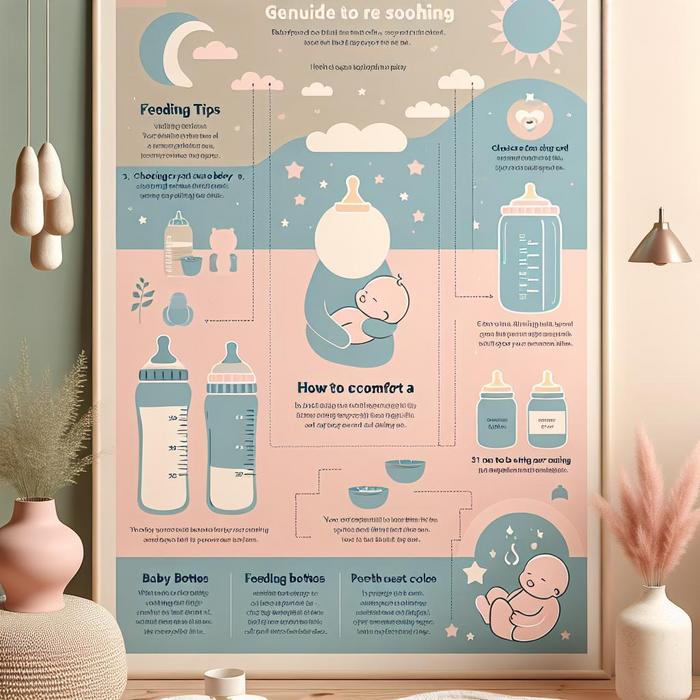Understanding Your Baby’s Feeding Patterns
Starting the transition from breast to bottle can be a milestone event for both you and your baby. It’s crucial to understand your baby’s feeding patterns to ensure that this transition is a smooth one. Here are some bottle-feeding tips that can help soothe your baby.
1. Choose the Right Bottle and Nipple
The first step is to choose the right bottle and nipple for your baby. This can often be a trial and error process as what works best largely depends on your baby’s preference. According to BabyCenter, it may be helpful to select a bottle that mimics the breast to make the transition easier.
2. Maintain Close Physical Contact
One aspect of breastfeeding that babies love is the close physical contact with their mother. So, when you’re bottle-feeding, try to maintain this sense of closeness. Hold your baby in a comfortable position, and switch sides halfway through the feed to mimic breastfeeding.
Recognizing Hunger Cues
Recognizing your baby’s hunger cues can make bottle-feeding a much more comfortable experience. Babies typically show they’re hungry in several ways, including:
- Smacking or licking lips
- Opening and closing mouth
- Sucking on lips, tongue, hands, fingers, toes, toys, or clothing
1. Don’t Wait Until Your Baby is Overly Hungry
If you wait until your baby is crying to feed them, they may be too frustrated or stressed to eat. By recognizing hunger cues early on, you can avoid this issue.
2. Pace the Feedings
Pacing the feedings is another essential bottle advice. This involves allowing your baby to drink at their own pace, taking breaks to burp and ensuring that they’re not swallowing air along with the formula.
Creating a Bottle-Feeding Routine
Creating a routine for bottle-feeding can give your baby the comfort and predictability they crave, making them feel more relaxed during each feeding session. This routine can include:
- Feeding at the same times each day
- Using the same chair or area for feedings
- Singing a special song or playing gentle music during feedings
Getting into a feeding routine helps set expectations for your baby and can make them more amenable to bottle-feeding over time.
Takeaway
Transitioning your baby from breast to bottle doesn’t have to be stressful. With the right tools and techniques, you can make this a smooth and enjoyable experience for both of you. Remember, every baby is unique, and what works for one might not work for another. So, it’s essential to pay attention to your baby’s signals and adjust accordingly.
3. Bottle-Feeding Challenges
There can be several challenges that you may encounter when bottle-feeding your baby, one of the most common issues being that babies consuming their feed too quickly. According to Welia Health, this problem can be addressed by practicing paced bottle-feeding, which lets your baby control the pace of the feed, helping prevent gassiness and colic.
Baby Colic and Bottle-Feeding
Colic is a condition that can cause babies to cry for several hours a day, often in the late afternoon or evening. While colic’s exact cause still remains rather unclear, studies suggest that certain feeding habits might contribute to it. The NHS suggests feeding your baby in a quiet, relaxed environment and making sure you take breaks during the feed for burping, as these measures can help curb colic symptoms.
Feeding on Demand vs. Scheduled Feedings
A common question among parents pertains to whether they should stick to the timed feedings or feed their baby on demand. Experts suggest it is crucial to understand that every baby is unique and consequently has unique feeding needs. Feeding on demand doesn’t mean you have to drop everything the minute your baby shows signs of hunger. It means offering a feed when they’re showing early signs of hunger and not withholding a feed based on the clock.
Bottle-Feeding Concerns
Bottle-feeding a baby can lead to a series of doubts and concerns due to misconceptions and widespread myths. One common concern is that bottle-fed babies are more prone to overfeeding. This can potentially lead to discomfort and spit-ups. However, as rightly pointed out by KidsHealth.org, being aware of the baby’s hunger and fullness cues can help prevent overfeeding and make sure your baby gets just the right amount of nourishment.
Role of a Paediatrician
A good pediatrician can be your best ally when transitioning to bottle-feeding. Regular health check-ups will help your doctor monitor your baby’s growth and ensure they’re feeding adequately. This allows you to seek professional advice concerning any feeding-related issues that may arise and ensure you’re providing the best possible care to your baby.
Bottle Sterilisation
Baby bottle sterilization is a vital step in the feeding process to prevent the spread of bacteria and infections. Be sure to rinse the feeding items in cold water as soon as possible after feeds. Then, clean them thoroughly with a mild detergent and lukewarm water. Once clean, sterilize them by using a home sterilizer or boiling them in water.
Baby Cues During Bottle-Feeding
Apart from understanding hunger cues, it’s equally essential to understand cues indicating that your baby is done feeding. These may include turning their head away, sealing their lips, or even falling asleep. Over time, getting familiar with your baby’s cues can help you better recognize their needs and preferences.
In conclusion, transitioning from breast to bottle-feeding is a significant milestone that can bring about both challenges and joys. With patience, consistency, and a keen understanding of your baby’s cues, this transition can be a fulfilling experience that strengthens the bond between you and your baby.

